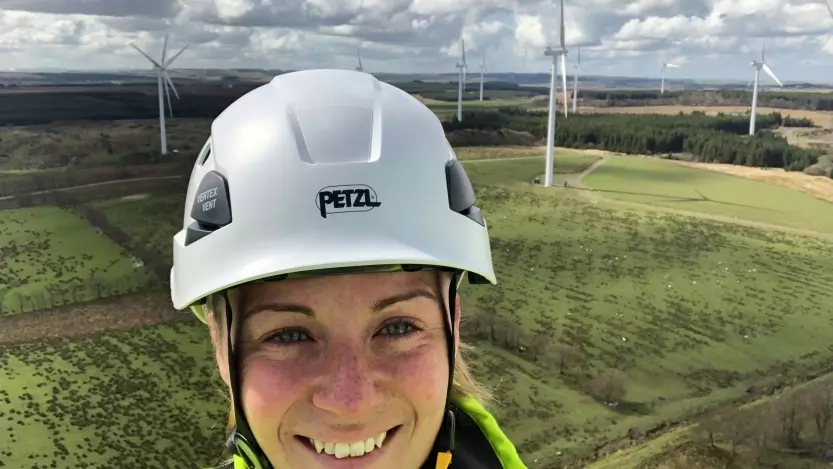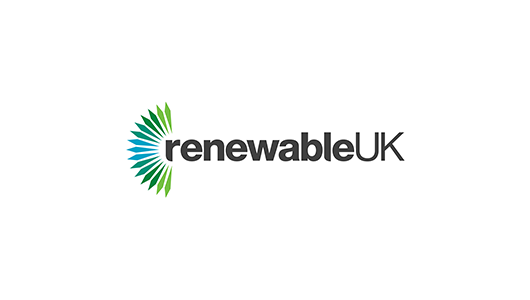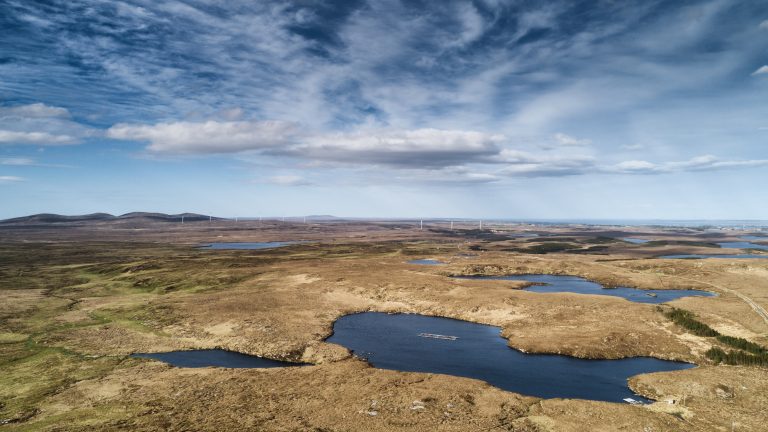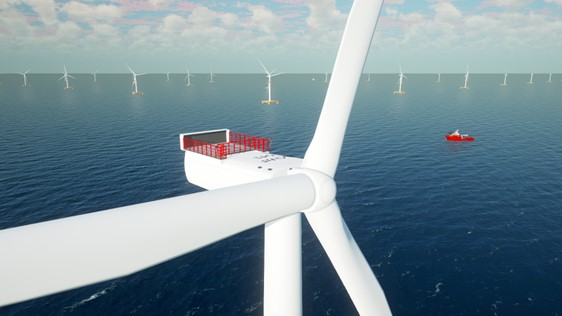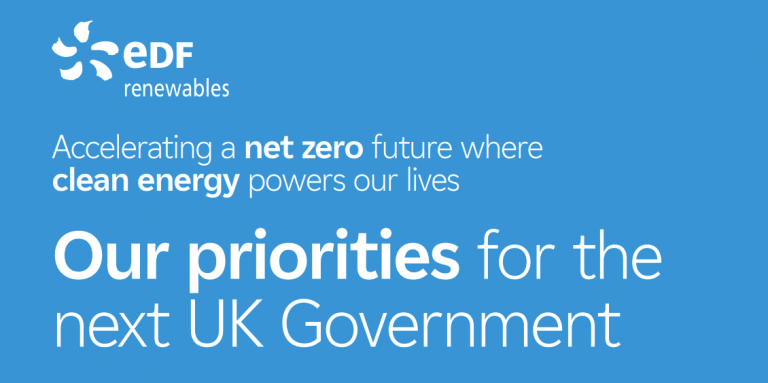
Imagine a job that gets you outside in the fresh air and which delivers breath-taking views of Scotland every day … and you get a wee taster of what Laura Noone’s job as Area Manager for EDF Renewables in North Scotland involves. We caught up with one of the busiest women working in wind power to find out more about her role and how she broke into the hugely in-demand renewables industry.
Day-to-day working life in renewables
Q. Where are you right now?
A. I’m sitting outside the control building in my car at Dorenell wind farm. I’m looking out onto a landscape of wind turbines, hills and trees… you couldn’t work anywhere more beautiful.
I look after Dorenell wind farm, EDF Group’s largest onshore wind farm in Europe, which is in the North East of Scotland.

I also manage Corriemoillie, a 17-turbine site, in the North West of Scotland, near Garve in the Scottish Highlands. My base is slap bang in the middle of the two sites – in Inverness – and I cover the North of Scotland in my role. These two wind farms are unique, as the nearest site to either of them is about 3 hours’ drive away… They’re not close to anything else! But I think myself lucky for having the best views on the planet.
I’m officially home-based. I don’t have an office location, but I split my time between the two sites. So for three or four days every week, I’ll be out at either wind farm. And then I spend the remainder of my time working from home.
Q. What does your job involve?
A. As area manager, I’m responsible for the day-to-day management of both sites: the teams working there and what’s going on. I like to be on site to be present for my teams. So I’m here on site at Dorenell today, because we’re doing a transformer exchange. It’s a major component replacement, so I’m here to make sure it all runs smoothly.
Q. What’s a typical day like?
A. This isn’t a 9-5 job, as the turbines don’t work those hours! And every day on site is different. But that’s what we all love about it.
Whether I’m on site or at home, I’ll get the technicians set up for the day’s work. Generally, the technicians work 7am-3pm – so I’ll start early too. I have a meeting with the lead technician first to check the plan for the day and to make sure we’ve caught anything new that’s come in. If there’s a turbine fault, we’ll adapt our working plan to include that. Then we make sure the technicians are prepped: so they have the right kit for the day and they know which turbines they’re working on.
When the technicians head out to the turbines, I catch up on day-to-day paperwork. I’ll also check in with the other site to make sure everything’s running smoothly there. And there’s usually a meeting or two in the diary too.
Sometimes the technicians return to the control building for lunch. But if they’re far away – it can take an hour to drive from one side of Dorenell to another! – they either take their lunch and sit in their van, or we have remote welfare units at strategic positions for them to use. In summer it’s great to be outside. But when you’re cold and ‘hangry’ in the winter or the rain, you want to be able to warm up with a hot drink, which is where the remote welfare units come in handy.
After the technicians finish in the turbines around 3pm, I’ll make sure everything is prepared for the following day (as much as possible anyway!), before catching up on meetings and paperwork to finish off my day. EDF Renewables is keen to ensure we have a very good work-life balance. So it’s not unusual to work a longer shift one day, then balance it off with an earlier finish the next. The most important thing is to make sure we meet our operational obligations.
Q. How has your job been impacted by Covid-19?
A. Power generation is essential for our day-to-day lives, so we were deemed as an essential resource during lockdown. We adapted some of our paperwork to allow us to continue providing maintenance of the turbines. But the biggest change for me was that I had to do everything remotely during lockdown. Only essential workers were permitted on site. We, therefore, adopted a greater use of digital communications –like Skype – and used conference calls to stay connected. This worked very effectively, particularly Skype instant messaging, by enabling anyone to reach me quickly.
As our number one priority is the safety of everyone working on site, we also had to put in place additional procedures to prevent the possible spread of the virus – particularly if we had multiple parties working there. We also had to make sure the sites were cleaned more often too.
But it was a very different kind of busy – as at the same time, I wasn’t doing any travelling. So I gained extra time from not having to commute to both sites all week. But it tended to get swallowed up with more paperwork and Skype calls!
Running a wind farm
Q. How do the two sites you’re responsible for differ from one another?
A. There’s not much difference between the turbines, in terms of their output and size. At Dorenell, we have 59 turbines. These are Vestas’ V90 machines and their output is 3 MW. The turbines at Corriemoillie are from GE and operate at 2.85 MW. The turbines at both sites are also about 80m high.
Dorenell is a very new site, as it only opened in September 2019. It’s also EDF Renewable’s biggest onshore site. Whereas Corriemoillie has been operating since 2017. It’s one of the best-running sites we have in the whole fleet. So much so that the GE team responsible for maintaining it had to go and work on another GE site to keep their training up to date, as they were getting so little practice at Corriemoillie!
Both sites get the same kind of weather conditions. Although Dorenell is in the North East and Corriemoillie in the North West of Scotland, they’re both located at similar altitudes. So the biggest challenge at both wind farms is snow and ice. Corriemoillie gets particularly affected by ice. The tracks are often not driveable – despite snow clearing. Whereas at Dorenell, blizzards are more likely to cause problems. Conditions can change very fast, so you need the survival kit in your car. Snow is definitely the harshest weather condition to work in.

Read more about the challenges of building a wind farm in snow in our blog from Ian Graham at EDF Renewables.
Q. Who looks after the maintenance and servicing of the wind farms?
A. It varies, depending on how the site is operated. At Dorenell, a team from Vestas (who made the turbines) look after day-to-day fault finding and warranty-related repairs of the turbines. So if there’s a problem on site, they’ll despatch a team to investigate the fault and – if possible – fix it there and then. They’ll report back to me and Vestas with an update.
Servicing at Dorenell is the responsibility of EDF Renewables, however. And since the site is so big – we have 59 turbines – Dorenell has a dedicated team of wind turbine technicians. There are nine in total, including one lead technician.
Corriemoillie wind farm is different. Here the wind turbines are from GE – and it’s a GE team who look after the servicing and maintenance of the turbines. They’ve been providing the service for a while now, so they work very efficiently. For instance, if they’re visiting a turbine to fix a fault and its service is due in 60 days, they’ll try and complete both tasks in one trip. It means they don’t need to revisit the turbine at a later date for the service. I’m the only EDF Renewables team member who’s involved in the day-to-day operation of Corriemoillie.
Q. How often are turbines serviced – and when does it take place?
A. At Dorenell, the turbines are serviced annually and we’re in that phase now. It takes four days to service each turbine. And, as we have 59 turbines, it’s a mammoth effort!
Where possible, we try and complete the service in the summer months – basically when the weather is predicted to be at its best. It’s not so much the wind that’s a problem up here, but the snow can be so severe that we often can’t get on site. So we want to avoid any servicing during the winter months, whenever possible.
Q. What’s involved in a service?
A. It’s basically a big MOT on each turbine. So the technicians check the oil and grease, top up the coolant, check everything’s aligned properly, make sure there aren’t any leaks, check bolts and so on… Basically, make sure all parts are doing what we expect. Some wear and tear is inevitable. So our technicians have a checklist, which gives an indication of what kind of deterioration we can expect to see after one year, two years, and so on.
Q. How has Covid-19 affected the servicing and maintenance of the wind farms?
A. Ordinarily, we could add a third technician onto the teams servicing each turbine at Dorenell. But to abide by social distancing rules, we can only have teams of two in a turbine at any time. So unfortunately we don’t have that back-up option of adding a third member if we fall behind on timings.
Q. How do you keep track of each turbine’s performance?
A. I work closely with our in-house performance analysis team, and I have remote access to all turbines – so I can see what’s happening on-site from wherever I am. The performance team provide great in-depth analysis and give me information I can use to get the best efficiency out of the machines.
When I’m working from home, I have that page loaded up on one of my screens. And as it’s colour-coded, I can see really easily if there are any problems with the turbines. Everything is green when it’s working correctly. But whenever there’s a fault, the turbines are flagged on screen as grey or red, depending on the issue.
Your career journey
Q. How long have you worked at EDF Renewables?
A. I’ve been with the company since December 2017. I was responsible solely for Corriemoillie back then. But I was brought in for my experience in managing handovers between construction and operation. So I was involved in Dorenell from the start of construction. It meant that when handover took place, I knew a lot about the site already.

Q. Have you always worked in renewables?
A. My dissertation during my final year at university was on the use of low-carbon technologies. So I always had a desire to get into the renewables industry. After graduating, I worked for a company doing a hybrid role, which drew on my civil engineering experience and also involved working on a wind farm. I discovered I was good at the construction side – but that I could also do the organisation and operational side of things. So I fell into that side more, and I really love it.
Q. What did you study at school?
A. For my Highers, I focused on physics, maths, modern studies and PE. I didn’t like chemistry or biology, but I really enjoyed physics. It’s routed in maths – which I love – so it definitely played to my strengths.
Q. Did you stay on in education?
A. I studied a degree in civil engineering at the University of the West of Scotland (back then, it was called Paisley University). There were about 40 people in my year and I was the only girl. It never bothered me, but I’m pretty confident.
Q. Are there many women working in renewables?
A. My experience at university set me up for working in an industry that’s extremely male dominated! I know the industry is trying to address the gender balance and there are women at EDF Renewables working in all kinds of roles. But out in the field, it would certainly be good to see a few more of us! Hopefully the gender split will be more balanced in the future, as I know EDF Renewables is actively trying to recruit a more diverse workforce.

